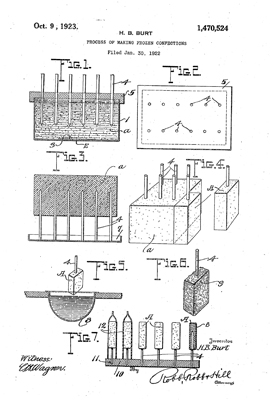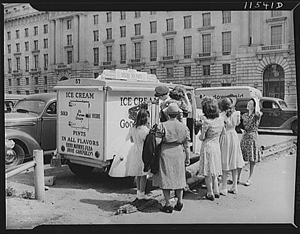 In 1920, a candy maker in Youngstown, Ohio created a recipe for coating ice cream with chocolate. Harry Burt’s smooth chocolate coated ice cream treats were delicious. The first taste tester was his daughter Ruth who loved the flavor but hated the mess. Earlier, Burt had invented a lollipop on a stick known as a Jolly Boy Sucker. Taking the advice of his son, Harry Jr., Burt froze the same stick into his ice cream, creating handles for the treats. Burt named his new ice cream invention the Good Humor Bar. The name came from the belief that a person’s humor or temperament came from their sense of taste.
In 1920, a candy maker in Youngstown, Ohio created a recipe for coating ice cream with chocolate. Harry Burt’s smooth chocolate coated ice cream treats were delicious. The first taste tester was his daughter Ruth who loved the flavor but hated the mess. Earlier, Burt had invented a lollipop on a stick known as a Jolly Boy Sucker. Taking the advice of his son, Harry Jr., Burt froze the same stick into his ice cream, creating handles for the treats. Burt named his new ice cream invention the Good Humor Bar. The name came from the belief that a person’s humor or temperament came from their sense of taste.
On January 30, 1922, Burt applied for patents on the process and manufacturing of the frozen treat as well as for the treat itself. The United States Patent Office was reluctant to grant the patents because of the product’s similarities to Eskimo Pies. It took a trip to Washington, D.C. with a five-gallon bucket of Good Humor bar samples before his patent would be approved. Ultimately, Burt received US Patent 1,470,524 for the Process of Making Frozen Confections on October 9, 1923. He did not receive a patent for the confection itself.
The broad basis of Burt’s patent led to a popsicle battle between the major manufacturers. In 1925, Burt sued both of his major competitors, the Citrus Products Company and the Popsicle Corporation for producing similar frozen treats. Eventually, he dropped the suit against the Citrus Products Company because he realized they refused to settle in order to see if his patent would hold up in court. Burt and Popsicle reached an agreement out of court. Popsicle paid a licensing fee to Burt and was permitted to manufacture frozen treats from ice and sherbert. Burt kept the exclusive rights to produce the frozen suckers from ice cream and other dairy products.
 Harry Burt not only invented chocolate-covered ice cream on a stick, but also pioneered a new way to distribute his product. He created a fleet of trucks driven by Good Humor men in white uniforms. The trucks were outfitted with bells to alert the children of the ice cream trucks arrival. The combination of a tasty treat and wholesome, trustworthy employees led to great success for Harry Burt and to the popularity of the ice cream truck.
Harry Burt not only invented chocolate-covered ice cream on a stick, but also pioneered a new way to distribute his product. He created a fleet of trucks driven by Good Humor men in white uniforms. The trucks were outfitted with bells to alert the children of the ice cream trucks arrival. The combination of a tasty treat and wholesome, trustworthy employees led to great success for Harry Burt and to the popularity of the ice cream truck.
In the 1950’s, during the height of its popularity, the company operated over 2,000 trucks serving tasty treats to children all over the country. Slowly, the company began facing more and more competition from other ice cream vendors. In 1976, after a steady decrease in sales, Good Humor sold off its fleet of ice cream trucks and focused more on sales in the grocery store. Good Humor is now part of the world’s largest maker of ice cream products, Unilever.

